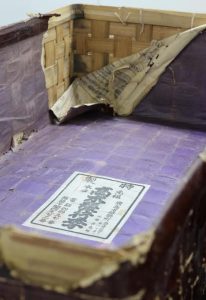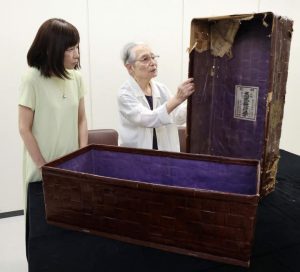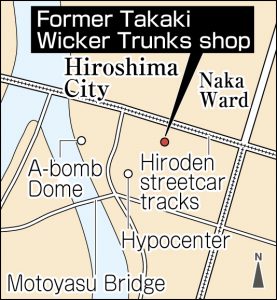Striving to fill voids in Hiroshima—Wicker trunk made at shop in devastated former Sarugaku-cho revealed to deceased shopkeeper’s family
Aug. 3, 2023
“Can feel the breathing of the craftspeople”
by Kyoko Niiyama, Staff Writer
At one time, the Takaki Wicker Trunks shop was located in the former Sarugaku-cho (now part of Hiroshima’s Naka Ward), an area under the hypocenter and annihilated in the atomic bombing. The shop owner was killed in the bombing, and all the shop’s merchandise was incinerated. This past summer, 78 years after the bombing, it was learned that a wicker trunk made at the shop during the war still exists today. A family member of the deceased shopkeeper came into contact with the trunk through arrangements made by its current owner and, with that, was able to recall the lives of people lost in the bombing.
“I’m so pleased you’ve held on to it.” Miyukiko Takaki, 94, a resident of Hiroshima’s Naka Ward and a member of the family of the deceased owner of the wicker trunk shop, smiled as she spoke in front of the wicker trunk, the surface of which has peeled off in places. The trunk’s owner, Yurika Hashimoto, 56, lives in Hiroshima’s Asaminami Ward. It was purchased by her grandmother around 1938 as part of an assortment of goods for marriage when her grandmother married into a family in Higashihiroshima City. Ms. Hashimoto’s mother inherited the trunk from her grandmother, and then Ms. Hashimoto from her own mother.
Woven from bamboo, covered with Japanese paper, and coated with persimmon tannin, the trunk measures around 83-centimeters wide, 40-centimeters long, and 22-centimeters high. A label on the inside of the trunk lid reads “Wicker trunk made by Takaki, Hiroshima’s Sarugaku-cho, one-and-a-half blocks east of Product Exhibition Hall.” Ms. Hashimoto said, “I’ve held on to it because when I heard the former Sarugaku-cho was located close to the hypocenter, I thought the trunk might be of value to someone.” The previous month, hearing about Ms. Takaki from a Chugoku Shimbun reporter, she decided to show the trunk to her.
In 1945, located at a spot around 260 meters east of the A-bomb Dome, the Takaki shop made and sold wicker trunks. Shigezaburo Takaki, the shopkeeper, and his family, six in all, lived in the shop, which doubled as the family home.
At the time of the atomic bombing, Shigezaburo, then 49, was at the shop and killed instantly. “I heard that his remains were found in a face-down position.” Shigezaburo’s oldest son, Seiji, who died in 2018 and had avoided the bombing because he was under medical care in Shimane Prefecture, reported that information about his father in a testimony of his that is archived at the Hiroshima Peace Memorial Museum, in the city’s Naka Ward. Several craftspeople who had been working in the shop are also thought to have fallen victim to the atomic bombing. Ms. Takaki said, “I have heard that before the bombing many soldiers used to come to the shop looking to buy military wicker trunks.” Her older brother, who died in the war, was one of them.
Seiji and the surviving family rebuilt the shop in that ruined part of Hiroshima and reopened the business soon after the war, utilizing materials that had been evacuated elsewhere. Ms. Takaki married Seiji in 1958 and helped in the shop’s operations. Although the shop closed in 1973, she still lives at the shop’s former location with her oldest daughter and her daughter’s husband. No wicker trunks made during the war remained in Ms. Takaki’s house. Hironobu Ochiba, a curator at the Peace Memorial Museum, said, “The trunk is valuable in that it speaks to the existence of the area and the daily lives of the people in Sarugaku-cho that were lost in the atomic bombing.”
Ms. Hashimoto said, “I will cherish the trunk, imbued as it is with the feelings of the shopkeepers who died in the bombing.” Ms. Takaki experienced the atomic bombing as a student at a girls school and thus knows the horror of that day. Through tears, she explained, “I can sense their efforts to make stout products during the war even when there were material shortages. I can feel the daily movements and the breathing of my father-in-law and the craftspeople back then who died in the bombing.”
(Originally published on August 3, 2023)










